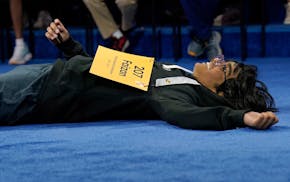The Trump administration wants to remove Chinese students from the U.S., with Secretary of State Marco Rubio saying on Wednesday that the country would "aggressively revoke visas" especially for those who have connections to the Chinese Communist Party or are studying in critical fields.
And broad numbers show that Minnesota will feel an impact.
In 2024, students from China made up 19.2% of the nearly 15,000 international students enrolled at the state's colleges and universities, or nearly 2,900 students, according to Open Doors data.
The greatest number — 2,160 students — attend the University of Minnesota, which has enrolled students from China since 1914 and opened an international office in Beijing in 2009, according to the U's China Center website.
The Star Tribune reported in 2020 that tuition payments from Chinese students had brought in nearly half a billion dollars in revenue in the previous decade. The windfall helped the university weather the Great Recession of 2007-09, and avoid higher tuition increases for Minnesota students.
Professor Galin Jones, director of the U's School of Statistics, described the move to revoke Chinese students' visas as "disappointing and shortsighted."
"We're very competitive in artificial intelligence … but a lot of that relies upon the talent that is recruited from outside of the U.S., bringing them here as graduate students, training them and allowing them to do what they're really good at," Jones said.
He said there are not enough domestic applicants to these programs "to keep us on the cutting edge in research and development in those areas."
Jones estimated that Chinese students comprise at least half of the statistics school. He said it would be "utterly devastating to our program if we can't have the best international students work here."
"Chinese students are incredibly nervous about this. Even students who are close to graduating, they're nervous about their work just being wasted," Jones said.
"A lot of them feel very strongly about wanting to stay here and work here and contribute to our society, and it seems like those dreams are just being taken away."
The U said in a statement that it is awaiting clarity on the State Department's pause on visa interviews for international students.
"Our teams are working diligently to measure the short- and long-term impact of this and other changes in the federal landscape, especially for our students," said Andria Waclawski, director of public relations.
"The University is actively engaged, providing resources to our entire community and personalized support to those potentially impacted by recent developments."
Carleton College in Northfield has about 250 international students; 47% of them are from China.
President Alison Byerly said it's too soon to tell how Carleton's Chinese students will be affected. She said the college is in touch with them. She said the stated criteria of students studying "critical fields" is vague, and it's unclear whose visas will be revoked.
Chancellor Scott Olson of Minnesota State said that while the largest groups of international students are likely South Asian, followed by sub-Saharan African students, he was concerned about the crackdown on Chinese scholars.
"Do China and the U.S. need to understand each other?" he asked. "It's going to be a more peaceful world if we're in conversation with students from China."
A spokesperson for the Minnesota State system said 53 Chinese students were enrolled this spring semester, with 18 at St. Cloud State University and a dozen spread across four metro colleges.
At Macalester College in St. Paul, 69 Chinese students are enrolled, more than half of its international student population, according to enrollment data posted on its website.
The announcement about Chinese students is the latest in a flurry of Trump administration moves on the status of international students studying in the United States. Federal courts have voided some of its orders, and the administration itself has also reversed course in some instances.
The moves have left students, their families and school officials in a state of confusion and fear as the current school year wraps up.
Reuters interviewed a Chinese student, identified only as Wu, who said she had recently been accepted into the University of Minnesota Duluth and had no alternate plan if her visa was not approved. After seeing the news out of the U.S., she said, she started trying to arrange a mid-June interview at the U.S. Consulate in Shanghai to press her case.
"At nearly midnight, I saw the news and immediately started booking. The page crashed several times," Wu told reporters.
China sends more international students to the U.S. than any other country besides India. For the 2023-24 school year, more than 277,000 Chinese students were enrolled in U.S. universities and colleges, though that's significantly down from the more than 370,000 in 2019, according to data from Open Doors, Institute of International Education (IIE).
Erin Adler from the Minnesota Star Tribune contributed to this story.
Trump administration puts Minnesota towns and counties on immigration 'sanctuary' watch list

Russell Brand pleads not guilty to charges of rape and sexual assault in London court

Faizan Zaki overcomes a shocking, self-inflicted flub and wins the Scripps National Spelling Bee

Gov. Tim Walz to give political speeches in South Carolina and California, fueling 2028 speculation

